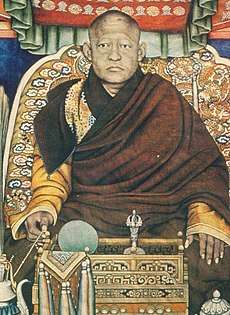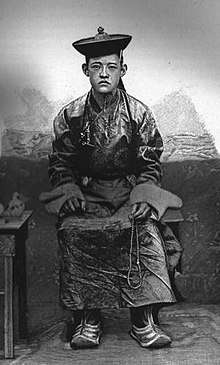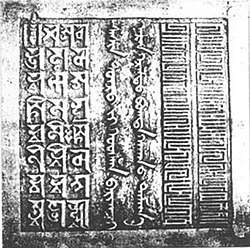Bogd Khan
The Bogd Khan (Mongolian: Богд хаан;[1] c. 1869 – 20 May 1924) became the Bogd Gegeen Ezen Khaan of Bogd Khaganate in 1911, when Khüree declared independence from Qing dynasty of China after the Xinhai Revolution. He was born in Tibet. As the 8th Jebtsundamba Khutuktu, he was the third most important person in the Tibetan Buddhist hierarchy, below only the Dalai Lama and Panchen Lama, and therefore also known as the "Bogdo Lama". He was the spiritual leader of Outer Mongolia's Tibetan Buddhism. His wife Tsendiin Dondogdulam, the Ekh Dagina ("Dakini Mother"), was believed to be a manifestation of White Tara.
Agvaanl Uvsanchoijinyam Danzan Vanchüg | |
|---|---|
 | |
| His Holiness the 8th Jebtsundamba Khutughtu | |
| Preceded by | Agvaanchoyjivanchugperenlaijamts, 7th Jebtsundamba Khutughtu |
| Succeeded by | Jambalnamdolchoyjijantsan, 9th Jebtsundamba Khutughtu |
| Khagan of Mongolia | |
| In office 1911–1924 | |
| Preceded by | Sando, as Amban of Outer Mongolia |
| Succeeded by | Peljidiin Genden, as head of state of Mongolian People's Republic |
| Personal details | |
| Born | 1869 Litang, Sichuan, Qing Dynasty |
| Died | 20 May 1924 (aged 54–55) Niyslel Khüree, Outer Mongolia |
| Spouse(s) | Tsendiin Dondogdulam |
Life


The future Bogd Khan was born in 1869 in Lithang, Kham, in a family of a Tibetan official.[2] He was born as Agvaanl Uvsanchoijinyam Danzan Vanchüg. His father, Gonchigtseren, was an accountant at the 12th Dalai Lama's court.[3] The boy was officially recognized as the new incarnation of the Bogd Gegen in Potala in the presence of the 13th Dalai Lama and the Panchen Lama.[4] The new Bogd Gegen arrived in Urga, the capital of Outer Mongolia, in 1874. After this he lived only in Mongolia.
According to one eyewitness,
...he did not become a puppet in the hands of the lamas but, on the contrary, took them in hand. Since his young years he wanted to restore the great Mongolian kingdom of Genghis Khan or, at least, to liberate Mongolia from the Chinese and make it self-dependent. Local princes feared him, but the masses liked him... An independent and clever first hierarch and ruler was unacceptable neither for Tibet, nor for the Chinese.[5]
As a result, from his young years the 8th Bogd Gegen was the subject of intrigues of Qing officials in Urga. Later he became the subject of propaganda campaigns organised by Mongolian Communists, which attacked him by alleging that he was a prolific poisoner, a paedophile, and a libertine, which was later repeated in belles-lettres and other non-scientific literature (e.g. James Palmer). However, analysis of documents stored in Mongolian and Russian archives does not confirm these statements.[6][7]
As a monk, the Bogd had limited access to physical means of imposing power, though some enemies were executed for blasphemy. The Polish traveller Ferdinand Ossendowski recorded that he knew "every thought, every movement of the Princes and Khans, the slightest conspiracy against him, and the offender is usually kindly invited to Urga, from where he does not return alive.[8] Ossendovsky's claims for his acquaintance with the Bogd Gegen were not confirmed by comparative analysis of his book and manuscripts.[9]
By the spring of 1911, some prominent Mongolian nobles including Prince Tögs-Ochiryn Namnansüren persuaded the Jebstundamba Khutukhtu to convene a meeting of nobles and ecclesiastical officials to discuss independence. The Khutukhtu consented. To avoid suspicion, he used as a pretext the occasion of a religious festival, at which time the assembled leaders would discuss the need to reapportion taxes among the khoshuuns. The meeting occurred on July 10 and the Mongolians discussed whether it would be better to submit to or resist the will of the Qings. The assembly became deadlocked, some arguing for complete, others for partial, resistance. Eighteen nobles decided to take matters into their hands. Meeting secretly in the hills outside of Urga, they decided that Mongolia must declare its independence. They then persuaded the Khutuktu to send a delegation of three prominent representatives—a secular noble, an ecclesiastic, and a lay official from Inner Mongolia—to Russia for assistance.[10] The particular composition of the delegation—a noble, a cleric, and a commoner—may have been intended to invest the mission with a sense of national consensus.
On December 1, the Provisional Government of Khalkha issued a general proclamation announcing the end of Qing rule and the establishment of a theocracy under the Jebtsundamba Khutuktu. On December 29, the Khutuktu was formally installed as the Bodg Khaan of the new Mongolian state.
The Bogd Gegen lost his power when Chinese troops occupied the country in 1919. The Tusiyetu Khan Aimak's Prince Darchin Ch'in Wang was a supporter of Chinese rule while his younger brother Tsewang was a supporter of Ungern-Sternberg.[10] When Baron Ungern's forces failed to seize Urga in late 1920, the Bogd was placed under house arrest; then he was freed and reinstated by Ungern shortly before he took Urga in 1921.[11] After the revolution in 1921 led by Damdin Sükhbaatar, the Bogd Khan was allowed to stay on the throne in a limited monarchy until his death in 1924,[12][13] a year after that of his wife.
After death
The government took control of the Bogd Khan's seal after his death according to the 26 November 1924 Constitution of the Mongolian People's Republic.[14]
It was proposed that Zhang Zuolin's domain (the Chinese "Three Eastern Provinces") take Outer Mongolia under its administration by the Bogda Khan and Bodo in 1922 after pro-Soviet Mongolian Communists seized control of Outer Mongolia.[10]
After his death, the Mongolian Revolutionary government, led by followers of the Soviet Communists, declared that no more reincarnations were to be found and established the Mongolian People's Republic. However, rumors about a reincarnation of the Jebtsundamba Khutuktu appeared in northern Mongolia in that same year.[15] No traditional determination of the supposed incarnation was conducted. Another rumor appeared in 1925. In November 1926 the 3rd Great Khural of Mongolian People's Republic approved a special resolution that searches for reincarnations of the Bogd Gegen should not be allowed.[7] A final prohibition was approved by the 7th Congress of the Mongolian People's Revolutionary Party and the 5th People's Great Khural in 1928.[16]
Nevertheless, the next reincarnation of Bogd Gegen was found in Tibet as a boy born in 1932 in Lhasa. This was not announced until the collapse of the USSR and democratic revolution in Mongolia. The 9th Jebtsundamba Khutughtu was formally enthroned in Dharamsala by Tenzin Gyatso, the 14th Dalai Lama in 1991, and in Ulaanbaatar in 1999.
The Winter Palace of the Bogd Khan has been preserved and is a tourist attraction in Ulaanbaatar.
See also
References
Citations
- Full name: Богд Живзундамба Агваанлувсанчойжинямданзанванчүг, Bogd Jivzundamba Agvaanluvsanchoijinyamdanzanvanchüg
- Soninbayar, Sh. and Punsaldulam, B. 2009. Mongolyn Tusgaar Togtnol Oyuun Sanaany Ikh Unirdagch VIII Bogd Jevzundamba Khutagt. Ulaanbaatar.
- Sanders, Alan J. K. Historical Dictionary of Mongolia. p. 364. ISBN 9780810861916.
- Knyazev, N.N. The Legendary Baron. - In: Legendarnyi Baron: Neizvestnye Stranitsy Grazhdanskoi Voiny. Moscow: KMK Sci. Press, 2004, ISBN 5-87317-175-0 p. 67
- Tornovsky, M.G. Events in Mongolia-Khalkha in 1920-1921. - In: Legendarnyi Baron: Neizvestnye Stranitsy Grazhdanskoi Voiny. Moscow: KMK Sci. Press, 2004, ISBN 5-87317-175-0 p. 181
- Batsaikhan, O. Bogdo Jebtsundamba Khutuktu, the last King of Mongolia. Ulaanbaatar: Admon Publ., 2008, ISBN 978-99929-0-464-0.
- Kuzmin, S.L. and Oyuunchimeg, J. The Great Khan of Mongolia, the 8th Bogd Gegeen. - Aziya i Afrika Segodnya (Moscow, Russian Acad. Sci. Publ.), 2009, no. 1, pp. 59-64.
- Ferdinand Ossedowski, Beasts, Men and Gods (New York, E.P. Dutton & Co., 1922), 293.
- Kuzmin, S.L., Rejt, L.J. Notes by F.A. Ossendowski as a source on the history of Mongolia. – Oriens (Moscow, Russian Acad. Sci. Publ.), 2008, no. 5, pp. 97-110.
- Owen Lattimore; Sh Nachukdorji. Nationalism and Revolution in Mongolia. Brill Archive. pp. 171–. GGKEY:4D2GY636WK5.
- Kuzmin, S.L. The History of Baron Ungern. An Experience of Reconstruction. Moscow: KMK Sci. Press., ISBN 978-5-87317-692-2 p. 325-357
- Mark Juergensmeyer (16 May 2008). Global Rebellion: Religious Challenges to the Secular State, from Christian Militias to al Qaeda. University of California Press. pp. 139–. ISBN 978-0-520-93476-4.
bogda khan.
- Mark Juergensmeyer (10 May 1993). The New Cold War? Religious Nationalism Confronts the Secular State. University of California Press. pp. 118–. ISBN 978-0-520-91501-5.
- A. P. Samest Blaustein; Jay Adrian Sigler; Benjamin R. Beede (1977). Independence documents of the world. 2. Brill Archive. pp. 482–. ISBN 0-379-00795-9.
- Bawden C.R. The Modern History of Mongolia, 1968, Praeger publishers, New York, pp. 261-263
- Purevjav, S. and Dashjamts, D. BNMAU-d Sum, Khiid, Lam Naryn Asuudlyg Shiidverlesen Ni. Ulaanbaatar: Ulsyn Khevleliin Khereg Erkhlekh Khoroo Publ.
Sources
- Palmer, James (2009). The Bloody White Baron. Basic Books. ISBN 978-0-465-01448-4.
Bogd Khan Born: c. 1869 Died: 20 May 1924 | ||
| Regnal titles | ||
|---|---|---|
| Preceded by Khevt Yos Khan |
Khagan of Mongolia 29 December 1911 – 1919 1921 – 20 May 1924 |
Vacant |
| Religious titles | ||
| Preceded by Ngawang Chökyi Wongchuk Trinley Gyatsho |
8th Jebtsundamba Khutuktu 1870 – 20 May 1924 |
Vacant Title next held by Jampal Namdröl Chökyi Gyaltsen |